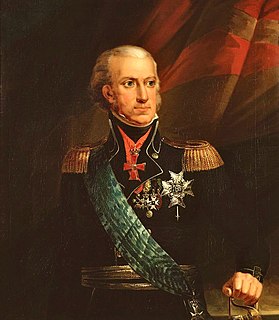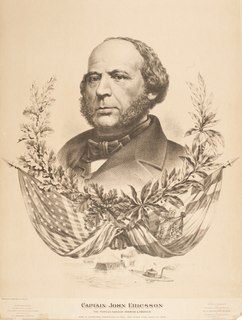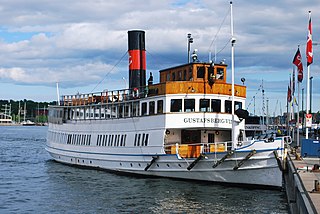

Experiment of Leith was a catamaran engineered by the Scottish banker Patrick Miller of Dalswinton, to be used by the Swedish fleet in the Russo-Swedish War (1788-90). By the time the ship reached Stockholm the war was, however, already over. [1]


Experiment of Leith was a catamaran engineered by the Scottish banker Patrick Miller of Dalswinton, to be used by the Swedish fleet in the Russo-Swedish War (1788-90). By the time the ship reached Stockholm the war was, however, already over. [1]
The ship had five masts, and the two hulls were each 32 metres long and 3.7 metres wide. In the absence of wind it could be driven by four or five paddlewheels powered by a capstan. Predating the marine implementation of steam power by a few decades [2] the ship was thus powered manually by the crew and was reported to have reached 4.3 knots. [3]
Experiment of Leith was anchored to the east of the island of Skeppsholmen in Stockholm where it remained for over four years until it was sunk in 1794 in order to form part of the foundation for a bridge. [1] [4]
The ship was a smaller version of one of Miller's earlier plans for a warship, which had been referred to by Swedish naval architect Fredrik Henrik af Chapman as the "Sea-Spook". [1] [5]
In return for the ship the king of Sweden, Gustavus III, gave Miller a golden box. It was the size of a snuff box and is kept today at the Victoria and Albert Museum [6] together with the letter of thanks from the Swedish king, dated 20 May 1791. [3]
The box contained swede seeds which Miller planted, and which are said to have started the Scottish taste for turnips [1] [3] or "neeps", eaten for example as a classic side to the national dish haggis. [7]

The Kalmar Union was a personal union in Scandinavia, agreed at Kalmar in Sweden, that from 1397 to 1523 joined under a single monarch the three kingdoms of Denmark, Sweden, and Norway, together with Norway's overseas colonies.

A ship of the line was a type of naval warship constructed during the Age of Sail from the 17th century to the mid-19th century. The ship of the line was designed for the naval tactic known as the line of battle, which depended on the two columns of opposing warships maneuvering to volley fire with the cannons along their broadsides. In conflicts where opposing ships were both able to fire from their broadsides, the opponent with more cannons firing — and therefore more firepower — typically had an advantage. Since these engagements were almost invariably won by the heaviest ships carrying more of the most powerful guns, the natural progression was to build sailing vessels that were the largest and most powerful of their time.

Charles XIII, or Carl XIII, was King of Sweden from 1809 and King of Norway from 1814 to his death. He was the second son of King Adolf Frederick of Sweden and Louisa Ulrika of Prussia, sister of Frederick the Great.

John Ericsson was a Swedish-American inventor. He was active in England and the United States.

Stockholm Palace or the Royal Palace is the official residence and major royal palace of the Swedish monarch. Stockholm Palace is on Stadsholmen, in Gamla stan in the capital, Stockholm. It neighbours the Riksdag building. The offices of the King, the other members of the Swedish Royal Family, and the Royal Court of Sweden are here. The palace is used for representative purposes by the King whilst performing his duties as the head of state.

Oscar Gustave Rejlander was a pioneering Victorian art photographer and an expert in photomontage. His collaboration with Charles Darwin on The Expression of the Emotions in Man and Animals has assured him a position in the history of behavioural science and psychiatry.

Patrick Miller of Dalswinton, just north of Dumfries (1731–1815) was a Scottish banker, shareholder in the Carron Company engineering works and inventor. Miller is buried in a tomb against the southern wall of Greyfriars Kirkyard in Edinburgh.

Storkyrkan, also called Stockholms domkyrka and Sankt Nikolai kyrka, is the oldest church in Stockholm. Storkyrkan lies in the centre of Stockholm in Gamla stan, between Stockholm Palace and Stortorget, the old main square of Stockholm. It was consecrated to Saint Nicholas in 1306 but construction of the church probably started in the 13th century. Inside, Storkyrkan still maintains much of its late medieval appearance in the form of a hall church with a vaulted ceiling supported by brick pillars. The exterior of the church is however uniformly Baroque in appearance, the result of extensive changes made in the 18th century. The church played an important role during the Reformation in Sweden as the place where Mass was celebrated in Swedish for the first time. It currently serves as the seat of the Bishop of Stockholm within the Church of Sweden since the creation of the Diocese of Stockholm in 1942.

SS Explorer is one of the last surviving sea-going steam trawlers and is registered to Leith, the port of Edinburgh. She has been placed on the National Historic Ships Register and the SS Explorer Preservation Society is currently restoring her in the Edinburgh Dock, Leith.

Fredrik Henrik af Chapman was a Swedish shipbuilder, scientist and officer in the Swedish navy. He was also manager of the Karlskrona shipyard 1782-1793. Chapman is credited as the world's first person to apply scientific methods to shipbuilding and is considered to be the first naval architect.

Princess Sophia Albertina of Sweden was the last Princess-Abbess of Quedlinburg Abbey, and as such reigned as vassal monarch of the Holy Roman Empire.

Carl Gustaf Anders Franzén was a Swedish marine technician and an amateur naval archaeologist. He is most famous for having located the 1628 wreck of the Swedish galleon Vasa in 1956 and participated in her salvage 1959–1961. He also participated in the exploration for the wrecks of Swedish warships Kronan, Riksäpplet and Resande Man as well as Gustav Vasa's flagship Lybska Svan.
Tranebergsbron is a double arch bridge in central Stockholm, Sweden. Stretching over the strait Tranebergssund it connects the major island Kungsholmen to the western suburb Bromma. It carries a road and metro tracks.

The Maritime Museum in Stockholm, Sweden is a museum for naval history, merchant shipping and shipbuilding. Located in the Gärdet section of the inner-city district Östermalm, the museum offers a panoramic view of the bay Djurgårdsbrunnsviken. The building was designed by architect Ragnar Östberg and built in 1933–36.

A steam yacht is a class of luxury or commercial yacht with primary or secondary steam propulsion in addition to the sails usually carried by yachts.

The following is a timeline of the history of the city of Stockholm, Sweden.

The Gustafsberg VII is a motor vessel, and former steam ship, that was built in 1912 at Oskarshamn. In 1929 she was sold to Waxholmsbolaget. After being written off in a sinking accident in 1964, she was bought by steamship enthusiasts, salvaged and restored. In 1973, Strömma Kanalbolaget bought the ship. She was converted to diesel power in 1985, and is now used for tourist services in the Stockholm archipelago. Over the years, she has also operated under the names Gustavsberg VII and Saxaren.

Storskär is a steamship that was built in 1908 in Gothenburg. She was originally named Strängnäs Express and traded between Stockholm and Strängnäs on Lake Malaren. She was transferred to service on the Stockholm archipelago in 1939, and given her current name in the following year. Storskär has operated for Waxholmsbolaget and her predecessors since 1939, and is today one of that company's classic fleet, alongside Norrskär and Västan. She is a listed historical ship of Sweden.

Västan is a motor vessel, and former steam ship, that was built in 1900 in Motala. She was originally named Nya Svartsjölandet and traded between Stockholm and Slut on Lake Mälaren. She was sold to Waxholmsbolaget for use in the Stockholm archipelago in 1937 and renamed Västan. She was converted to diesel power in 1953. The Västan is today the oldest of Waxholmsbolaget's classic fleet, operating alongside Storskär and Norrskär which, although newer, have retained their original steam propulsion. She is a listed historic ship of Sweden.

The Enköping is a Swedish motor vessel, and former steam ship, that was built in 1868 at Oskarshamn. Over the years, she has operated under the names Östhammar, Skokloster, Arholma, Väddö, Glafsfjorden, Södra Skärgården and Soten. In 1948 she was converted to diesel power. In 1990 Strömma Kanalbolaget bought her, and she is now used for tourist services on Lake Malaren and in the Stockholm archipelago. According to her owners, she is the oldest passenger ship still in service in the Lloyd's Register of Shipping, and she is a listed historic ship of Sweden.